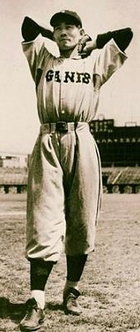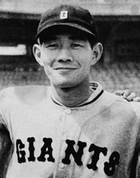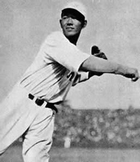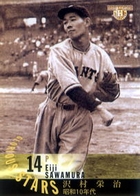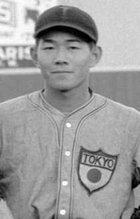Eiji Sawamura
| Date and Place of Birth: | February 1, 1917, Ujiyamada, Mie Prefecture, Japan |
| Date and Place of Death: | December 2, 1944 Taiwan Straits |
| Baseball Experience: | Japanese Professional League |
| Position: | Pitcher |
| Rank: | Unknown |
| Military Unit: | 33rd Regiment, 16th Division, Imperial Japanese Army |
| Area Served: | China/Pacific |
Hall of Famer Eiji Sawamura is an icon of Japanese baseball who served three tours of military duty
Eiji Sawamura was born on February 1, 1917 in Ujiyamada (now Ise
City), Mie Prefecture, Japan. The eldest son to Kenji and Michie
Sawamura, Eiji was introduced to baseball by his father in elementary
school.
Sawamura attended Kyoto Shogyo high school and played in three Koshien
Tournaments. Although his team was eliminated in the first round of the
1934 tournament, the 17-year-old was considered the best young pitcher
in Japan, and was selected to play against an American all-star team
that visited his country that year. Sawamura would have the opportunity
to pitch against the mighty Babe Ruth, Lou Gehrig, Earl Averill, Charlie
Gehringer and Jimmie Foxx. But it would come at a price. Playing against
the American professionals meant he was expelled from high school and
forfeited his opportunity to attend Keio University the following
semester.
Sawamura made six appearances against the Americans. Statistically,
things don't look too impressive. He had no wins against four losses and
an ERA of 7.85, but numbers fail to tell the story of the game he
pitched against left-hander Earl Whitehill at Kusanagi Stadium, Shizuoka
on November 20, the highlight of the 15-game series. Locked in a
pitching duel, neither Whitehill or Sawamura allowed a run through the
first six innings. Sawamura struck out Gehringer, Ruth, Gehrig and Foxx
in a row, and had allowed only one hit (a single by Rabbit McNair in the
fourth). But in the seventh inning Lou Gehrig hit a solo homer for the
only tally of the contest.
Despite the loss, Sawamura was a national hero and there was much hype
about the possibility of the young pitcher playing professionally in the
United States. "I'm interested, but also afraid to go," he responded.
The following year, Sawamura was in the United States, albeit with a
touring Japanese team - Dai Nippon Tokyo Yakyu Club - Japan's first
professional team and forerunner of the Tokyo Giants. During the tour
Dai Nippon won 93 games against semi-pro squads and teams from the
Pacific Coast League. Sawamura pitched exceptionally well on the tour.
He beat the Oakland Oaks, 2-0, and defeated the Sacramento Solons, 2-1.
The losing pitcher for the Solons was Jerry Angelich, who, six years
later, would be killed in the Japanese attack on Pearl Harbor.
Sawamura had captured the interest of professional baseball teams and
scouts in America. One unscrupulous baseball scout even tried to get him
to sign by handing him some paper and asking the young pitcher for his
autograph, in the hope he wouldn't realize it was a contract he was
about to apply his name to.
Despite the temptations of US baseball, Sawamura was committed to
playing in the professional league that launched in Japan in 1936. He
made just four appearances for the Giants in the 14-game spring season
schedule but was a dominant force during the fall season with a
league-leading 13 wins and an outstanding 1.05 ERA. On September 25,
against Osaka at Koshien Stadium, Sawamura hurled the first no-hitter in
professional Japanese baseball (It was the first of three career
no-hitters). In post-season play he started in three straight games
against the Osaka Tigers to give the Giants the first ever professional
championship title in Japan.
In 1937, Sawamura dominated the spring season with a 24-4 record, and
league best 0.81 ERA. His 196 strikeouts in 244 innings was also a
league best. His form dipped during the fall season, winning just nine
games against six losses and, for reasons beyond his control, the
20-year-old's baseball career was over for the time being.
Since the summer of 1937, Japan had been at war with China - a
conflict known as the Second Sino-Japanese War. The war was the result
of Japanese desire to dominate China politically and militarily and to
secure its vast raw material reserves and economic resources. Sawamura
received his military draft notice in January 1938 and took basic
training at Tsu City, Mie Prefecture. In April, he joined the 33rd
Regiment of the 16th Division in Shanghai, China, and fought against
Chiang Kai-shek's army. During this time, Sawamura became renowned for
his grenade throwing skills and was often called upon to make tosses
that others could not achieve. On September 23, Sawamura suffered a
bullet wound to his left hand. He was hospitalized for a while, before
returning to active duty with his unit. It was not until October 1939,
that he was discharged from service.
After being away from professional baseball for two years, Sawamura
returned to the mound for the Giants in 1940. Grenade throwing had
damaged his arm and the 23-year-old adopted a sidearm motion that still
proved effective on occasion. In 12 starts he was 7-1 with a 2.61 ERA
and threw his third no-hitter on July 6 against Nagoya. He made 20
appearances in 1941 for a lackluster 9-5 record and 2.05 ERA.
Towards the end of the 1941 season, Sawamura married his girlfriend,
Yuko. Three days later he received a second draft notice and reported to
the 33rd Regiment headquarters. The regiment left Nagoya on November 20,
bound for the island of Palau, Micronesia. From there Sawamura set sail
for the Philippines and fought his way across the island of Mindanao.
Sawamura returned to Japan with his regiment in January 1943. He
rejoined the Tokyo Giants but the Sawamura of old was gone. In four
appearances (three starts) he lasted just 11 innings and walked an
uncharacteristic 12 batters while allowing 17 hits. His last outing was
on July 6 against Osaka, where he allowed five runs over three innings,
finishing the season with an 0-3 record and 10.64 ERA.
In 1944, the Tokyo Giants chose not to renew Sawamura's contract. Rather
than play for another team, the 27-year-old retired from professional
baseball. In October, as the tide of the war turned against the
Japanese, he received his third draft notice. The 33rd Regiment was
reactivated and was to be sent into combat. On November 27, Sawamura
boarded a transport ship bound for Leyte in the Philippines. The ship
never reached its destination. On December 2, 1944, the transport was
torpedoed and sunk by the submarine USS Sea Devil (SS-400) in the Taiwan
Straits.
Sawamura became an icon of Japanese baseball. The Sawamura Award was
created in 1947 to honor the best pitcher in Japanese professional
baseball, and he was one of nine initial inductees in to the Japanese
Baseball Hall of Fame. Statues of Sawamura stand at Shizuoka Kusanagi
Stadium and Kyoto Shogyo high school.
Some of the information for this biography was taken from Robert K. Fitts' excellent book, Banzai Babe Ruth. Published in 2012 by the University of Nebraska Press.
Date Added: February 12, 2013
Baseball's Greatest Sacrifice is associated with Baseball Almanac
Baseball's Greatest Sacrifice is proud to be sponsored by

